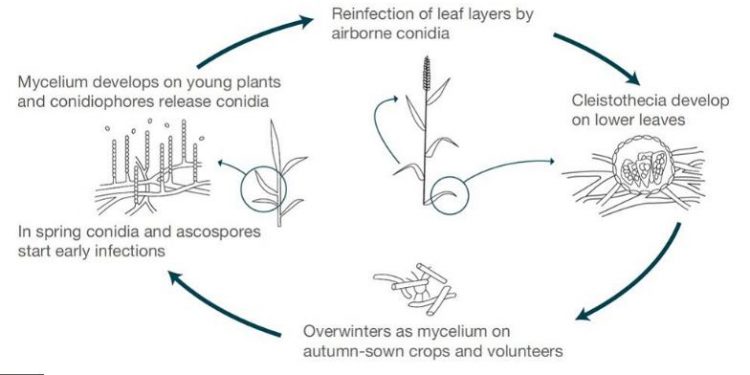Powdery mildew can infect all cereals. However, its visual appearance usually outweighs the damage potential, especially during the autumn and winter. In highly-susceptible varieties, yield losses can be up to 20% and early control can be very important. However, the disease generally causes much smaller yield losses (rarely exceeding 10%) and late attacks (after flowering) on the flag-leaf and ear rarely cause significant losses.
Crops under stress, late-sown crops, and crops that are growing rapidly in the spring are often particularly prone to attack. Early attacks can reduce tiller number and excessive nitrogen fertiliser can encourage the disease. Mildew can be particularly severe in dense crops.
Powdery mildew symptoms develop on leaves, stems and ears. Infection most commonly occurs on leaves, with symptoms occurring from autumn onwards. Typically, white, fluffy growth appears. This produces masses of spores with a powdery appearance. Eventually, black spore cases (cleistothecia) develop in the mildew growth, usually towards the end of the season.
In wheat, leaf yellowing is associated with infection. On yellowing leaves, growth retains a distinctive ‘green island’.
In barley, infection often causes the leaf to turn brown. A ‘hypersensitive response’ can occur when the plant tries to defend itself against powdery mildew infection, for example in resistant varieties. This leads to small dark brown flecks on the leaf, with no visible micelial growth.
Mildew can infect all cereals. However, there are several forms of the disease that are specific to individual crops and do not cross-infect.
Blumeria. graminis f. sp tritici affects wheat and triticale
Blumeria graminis f. sp. hordei affects barley
Blumeria graminis f. sp. avenae affects oats
Blumeria graminis f. sp. secalis affects rye
Wheat and barley varieties exhibit a wide range of resistances to powdery mildew. Many varieties have good disease resistance. However, monitor all varieties regularly for disease, as new races of pathogens can occur that could potentially overcome the resistance. In spring barley, grow varieties with effective resistance (provided by the ‘mlo’ gene), where possible. Some mildew can develop on these varieties, particularly on seedlings during dry conditions. However, resistance has proved reliable and effective over the past ten years. In some varieties, adult plant resistance, which only starts to become effective during stem extension, reduces infection on upper leaves.
The eradication of volunteer cereals, which act as overwintering sources of inoculum, and disposal of stubble and debris, infested with cleistothecia, can be important in mildew control. High levels of nitrogen fertiliser should be avoided, and later drillings tend to suffer more from mildew attack. Spring crops can easily become infected by airborne spores from nearby winter crops (but wheat will not pose a risk to barley and vice versa).
Fungicides with specific activity against mildew may be required where powdery mildew is a particular threat, although other fungicides, including azole/SDHI mixtures, have useful activity against powdery mildew. Several fungicides give effective protection when applied before symptoms become extensive, while others provide eradication and short-term control, but poor protection. Mixing these fungicide types will eradicate and protect against the disease.
Error




